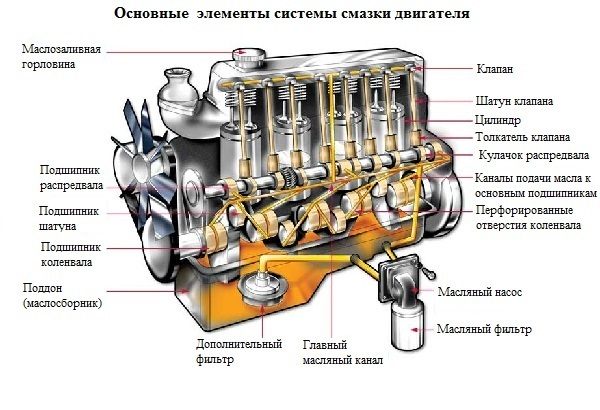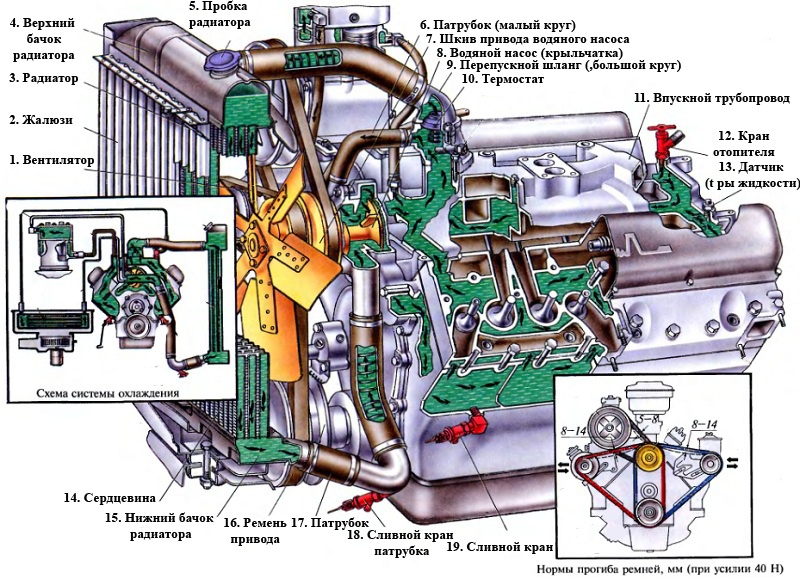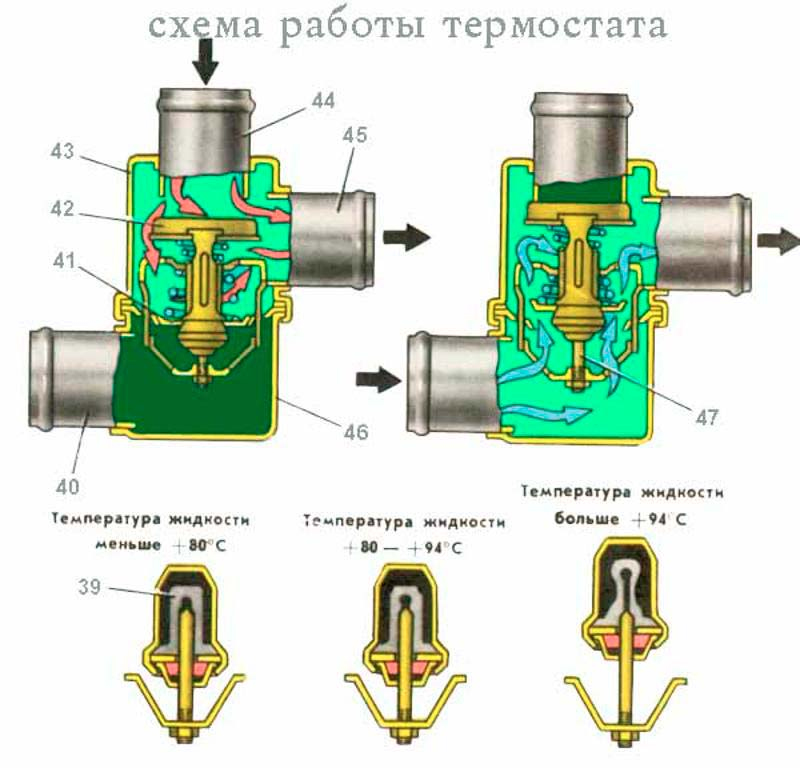
Purpose and principle of operation of the thermostat of the cooling system
An internal combustion engine, especially a modern and high-tech one, is a mechanism made with high precision. All his work is optimized for a certain temperature of all parts. Deviations from the thermal regime lead to a deterioration in the characteristics of the motor, a decrease in its resource, or even to breakdowns. Therefore, the temperature has to be precisely regulated, for which a temperature-sensitive device, a thermostat, is introduced into the cooling system.
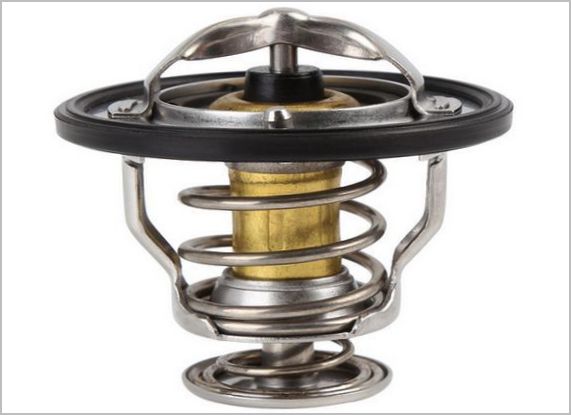
Typical design and control principle
Coolant (coolant) in the system is continuously pumped by a water pump - a pump. The heated antifreeze, which has passed through the cooling channels in the block and the motor head, enters its inlet. It is at this point that it is best to place a device to maintain a general temperature regime.
In the most common car thermostat, there are several parts that ensure its operation:
- a control cylinder containing a filler of a substance selected for reasons of maximum volume change after heating;
- spring-loaded valves that close and open two main fluid flow circuits - small and large;
- two inlet pipes through which antifreeze flows, respectively, from small and large circuits;
- outlet pipe that sends fluid to the pump inlet;
- metal or plastic housing with seals.
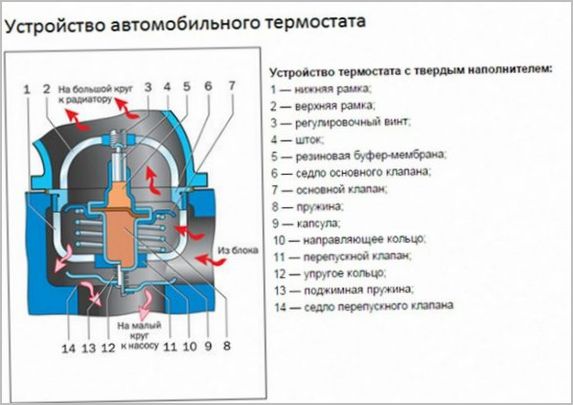
When the temperature of the liquid is insufficient, for example, when starting and warming up a cold engine, the thermostat is closed, that is, the entire flow leaving the engine is sent back to the pump impeller and from there again to the cooling jackets. There is circulation in a small circle, bypassing the cooling radiator. Antifreeze quickly gains temperature, without preventing the engine from entering the operating mode, while heating occurs evenly, thermal deformation of large parts is avoided.
When the lower operating threshold is reached, the filler in the thermostat slave cylinder, washed by the coolant, expands so much that the valves begin to move through the stem. The hole of the large circuit opens slightly, part of the coolant begins to flow into the radiator, where its temperature drops. So that the antifreeze does not go along the shortest path through the small circuit pipe, its valve begins to close under the influence of the same temperature-sensitive element.
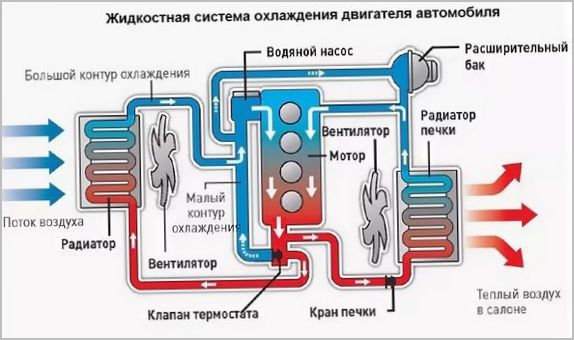
The ratio between the sections of the small and large flow circuits in the thermostat changes depending on the temperature of the liquid entering the body, this is how regulation is carried out. This is the default mode to ensure optimal performance is maintained. At the extreme point, the entire flow will be directed along the large circuit, the small one is completely closed, the thermostat's capabilities have been exhausted. Further rescue of the motor from overheating is assigned to emergency systems.
Varieties of thermostats
The simplest devices with one valve are no longer used anywhere. Powerful modern engines emit a lot of heat, while demanding on the accuracy of maintaining the regime. Therefore, even more complex designs are being developed and implemented than the described two-valve design.
You can often find mention of an electronic thermostat. There is no special intellectual stuffing in it, just the possibility of electric heating of the working element has been added. It is, as it were, deceived, reacting not only to the washing antifreeze, but also to the energy released by the current coil. In partial load mode, it will be more profitable to increase the coolant temperature to a maximum value of about 110 degrees, and at the maximum, on the contrary, reduce it to about 90. This decision is made by the engine control unit program, which supplies the required electrical power to the heating element. This way you can both increase the efficiency of the car, and prevent the temperature from quickly moving beyond a dangerous threshold at peak loads.

There are also double thermostats. This is done to separately control the temperature of the block and cylinder head. This ensures an improvement in filling, and hence power, on the one hand, and quick warm-up with minimization of friction losses, on the other. The temperature of the block is ten degrees higher than that of the head, and hence the combustion chambers. Among other things, it also reduces the tendency of turbo engines and high-compression naturally aspirated engines to detonate.
Troubleshooting and repair
Thermostat failure is possible in any condition. Its valves are able to freeze both in the circulation mode of a small circuit or a large one, and in an intermediate position. This will be noticeable by a change in the usual temperature or a distortion in the rate of its growth during warming up. If an economical engine is constantly operated with the large circle valve open, then it is unlikely to reach operating temperature at all under normal conditions, and in winter this will lead to the failure of the passenger compartment heater.
Partial overlap of the channels will make the engine work unpredictable. It will behave equally badly under heavy load and in warm-up mode. Such changes should be a signal to immediately check the thermostat, motors are very sensitive to excess and lack of heat.
Thermostats cannot be repaired, only unconditional replacement. The amount of work and the price of the issue depend on the specific design. On some cars, the active element with valves and a temperature-sensitive element is changed, on others - a thermostat with a housing assembly. A complex double or electrically controlled instrument has a very sensitive cost. But saving is inappropriate here, the new part must be original or from the most famous manufacturers, which is sometimes even higher in price than the original. It is best to find out which company's devices are used for the conveyor equipment of this model, and purchase them. This will eliminate the overpayment for the brand of the original, while maintaining the reliability of the original part.

It has been observed that thermostat failures often occur during routine maintenance of the cooling system. Especially after replacing antifreeze, especially if it has not been refreshed for a long time.
Devices do not like the stresses associated with the initial stay in the already not quite friendly environment of the aged coolant and the developed additives, replaced by decomposition products. As well as short-term exposure to oxygen-rich air, already on the verge of failure. Therefore, if the thermostat has a replaceable element that is inexpensive to purchase, it makes sense to immediately replace it with a new one. Thus, the driver will be spared from very likely troubles and a repeated visit to the service station.
If the owner has an inquisitive mind and likes to explore the details with his own hands, then the operation of the active assembly of the thermostat can be checked by observing the movement of its valves during boiling on a stove in a transparent bowl. But this hardly makes any special sense; new devices from a reputable manufacturer always work on the “set it and forget it” principle. And the resuscitation of the old is excluded for reasons of reliability of the car.
